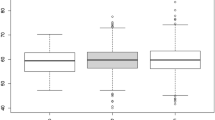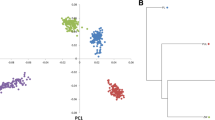Abstract
The analysis of structural genetic variability in candidate genes can make it possible to analyse the selection footprint and deepen the understanding of the genetic basis of complex traits. The leptin (LEP) and its receptor (LEPR) porcine genes are involved in food intake and energy homeostasis, and polymorphisms associated to growth and fatness traits have been detected in both genes. The main objective of this study was to explore the genetic variability of the most polymorphic regions of both genes in a variety of pig populations and wild boars from diverse European and Asian origins. In total, 54 animals were included in the analyses, with a remarkable sampling of Spanish wild boars and Iberian pigs. The sequencing allowed the identification of 69 and 26 polymorphisms in LEP and LEPR genes, respectively. Neighbour-joining trees built for the 69 haplotypes identified in the LEP and the 24 haplotypes detected in the LEPR showed the known genetic divergence between European and Asian pig breeds. A high variability of the LEP was detected in the different analysed populations providing new data for the existence of two domestication centres in Asia. In comparison to the LEP gene, the LEPR showed a lower variability, especially in the Iberian breed that showed no variability. Moreover, results of the Hudson-Kreitman-Aguadé neutrality test support a possible selection event of the LEPR gene region in this breed, potentially related with its leptin resistance pattern and good adaptation to a traditional extensive production system with strong seasonal changes of feeding resources.


Similar content being viewed by others
References
Alves E, Ovilo C, Rodríguez MC, Silió L (2003) Mitochondrial DNA sequence variation and phylogenetic relationships among Iberian pigs and other domestic and wild pig populations. Anim Genet 34:319–324
Amaral AJ, Ferretti L, Megens HJ, Crooijmans RP, Nie H, Ramos-Onsins SE, Perez-Enciso M, Schook LB, Groenen MA (2011) Genome-wide footprints of pig domestication and selection revealed through massive parallel sequencing of pooled DNA. PLoS ONE 6:e14782
D’Andrea M, Pilla F, Giuffra E, Waddington D, Archibald AL (2008) Structural analysis and haplotype diversity in swine LEP and MC4R genes. J Anim Breed Genet 125:130–136
Edgar RC (2004) MUSCLE: multiple sequence alignment with high accuracy and high throughput. J Nucleic Acids 32:1792–1797
El Mousadik A, Petit RJ (1996) High level of genetic differentiation for allelic richness among populations of the argan tree [Argania spinosa (L.)] endemic to Morocco. Theor Appl Genet 92:832–839
Esteve A, Ojeda A, Huang LS, Folch JM, Pérez-Enciso M (2011) Nucleotide variability of the porcine SERPINA6 gene and the origin of a putative causal mutation associated with meat quality. Anim Genet 42:235–241
Fabuel E, Barragán C, Silió L, Rodriguez MC, Toro MA (2004) Analysis of genetic diversity and conservation priorities in Iberian pigs based on microsatellite markers. Heredity 93:104–113
Fang M, Andersson L (2006) Mitochondrial diversity in European and Chinese pigs is consistent with population expansions that occurred prior to domestication. Proc Biol Sci 273:1803–1810
Fernández-Figares I, Lachica M, Nieto R, Rivera-Ferre MG, Aguilera JF (2007) Serum profile of metabolites and hormones in obese (Iberian) and lean (Landrace) growing gilts fed balanced or lysine deficient diets. Livest Sci 110:73–81
Fontanesi L, Russo V (2013) Nucleotide variability and haplotype heterogeneity at the porcine fat mass and obesity-associated (FTO) gene. Anim Genet 44:96–100
Frankham RJ, Ballou JD, Briscoe DA, MacInnes KH (2002) Introduction to conservation genetics. Cambridge University Press, Cambridge
Galve A, Burgos C, Silió L, Varona L, Rodríguez C, Óvilo C, López-Buesa P (2012) The effects of leptin receptor (LEPR) and melanocortin-4 receptor (MC4R) polymorphisms on fat content, fat distribution and fat composition in a Duroc x Landrace/Large White cross. Livest Sci 145:145–152
Gama LT, Martínez AM, Carolino I, Landi V, Delgado JV, Vicente AA, Vega-Pla JL, Cortés O, Sousa CO, BIOPIG Consortium (2013) Genetic structure, relationships and admixture with wild relatives in native pig breeds from Iberia and its islands. Genet Sel Evol 45:18
Giuffra E, Kijas JM, Amarger V, Carlborg O, Jeon JT, Andersson L (2000) The origin of he domestic pig: independent domestication and subsequent introgression. Genetics 154:1785–1791
Groenen MA, Archibald AL, Uenishi H, Tuggle CK et al (2012) Analyses of pig genomes provide insight into porcine demography and evolution. Nature 491:393–398
Hudson RR, Kreitman M, Aguadé M (1987) A test of neutral molecular evolution based on nucleotide data. Genetics 116:153–159
Kijas JM, Wales R, Törnsten A, Chardon P, Moller M, Andersson L (1998) Melanocortin receptor 1 (MC1R) mutations and coat color in pigs. Genetics 50:1177–1185
Kim KI, Lee JH, Li K, Zhang YP, Lee SS, Gongora J, Moran C (2002) Phylogenetic relationships of Asian and European pig breeds determined by mitochondrial DNA D-loop sequence polymorphism. Anim Genet 33:19–25
Larson G, Dobney K, Albarella U, Fang M, Matisoo-Smith E, Robins J, Lowden S, Finlayson H, Brand T, Willerslev E, Rowley-Conwy P, Andersson L, Cooper A (2005) Worldwide phylogeography of wild boar reveals multiple centers of pig domestication. Science 307:1618–121
Larson G, Albarella U, Dobney K, Rowley-Conwy P, Schibler J, Tresset A, Vigne JD, Edwards CJ, Schlumbaum A, Dinu A, Balaçsescu A, Dolman G, Tagliacozzo A, Manaseryan N, Miracle P, Van Wijngaarden-Bakker L, Masseti M, Bradley DG, Cooper A (2007) Ancient DNA, pig domestication, and the spread of the Neolithic into Europe. Proc Natl Acad Sci U S A 104:15276–15281
Laval G, Iannuccelli N, Legault C, Milan D, Groenen MA, Giuffra E, Andersson L, Nissen PH, Jørgensen CB, Beeckmann P, Geldermann H, Foulley JL, Chevalet C, Ollivier L (2000) Genetic diversity of 11 European pig breeds. Genet Sel Evol 32:187–203
Lee KT, Hwang H, Kang KS, Park EW, Kin JH et al. (2008) Genomic structure of porcine leptin receptor gene (LEPR)/LEPR overlapping transcript gene (LEPROT) and SNP discovery, association study. Congress of the International Society of Animal Genetics 2008, Amsterdam
Li N, Stephens M (2003) Modeling linkage disequilibrium and identifying recombination hotspots using single-nucleotide polymorphism data. Genetics 165:2213–2233
Librado P, Rozas J (2009) DnaSP v5: a software for comprehensive analysis of DNA polymorphism data. Bioinformatics 25:1451–1452
López-Bote CJ (1998) Sustained utilization of the Iberian pig breed. Meat Sci 49S1:S17–27
Luetkemeier ES, Sodhi M, Schook LB, Malhi RS (2010) Multiple Asian pig origins revealed through genomic analyses. Mol Phylogenet Evol 54:680–686
Maynard Smith J, Haigh J (1974) The hitch-hiking effect of a favourable gene. Genet Res 23:23–35
Morales J, Pérez JF, Baucells MD, Mourot J, Gasa J (2002) Comparative digestibility and lipogenic activity in Landrace and Iberian finishing pigs fed ad libitum corn- and corn–sorghum–acorn-based diets. Livest Sci 77:195–205
Nei M, Tajima F (1981) DNA polymorphism detectable by restriction endonucleases. Genetics 97:145–163
Ojeda A, Rozas J, Folch JM, Pérez-Enciso M (2006) Unexpected high polymorphism at the FABP4 gene unveils a complex history for pig populations. Genetics 174:2119–2127
Ojeda A, Huang LS, Ren J, Angiolillo A, Cho IC, Soto H, Lemús-Flores C, Makuza SM, Folch JM, Pérez-Enciso M (2008) Selection in the making: worldwide survey of haplotypic iversity around a causative mutation in porcine IGF2. Genetics 178:1639–1652
Ollivier L (2009) European pig genetic diversity: a minireview. Animal 3:915–924
Óvilo C, Oliver A, Noguera JL, Clop A, Barragán C, Varona L, Rodríguez C, Toro M, Sánchez A, Pérez-Enciso M, Silió L (2002) Test for positional candidate genes for body composition on pig chromosome 6. Genet Sel Evol 34:465–479
Ovilo C, Fernández A, Fernández AI, Folch JM, Varona L, Benítez R, Nuñez Y, Rodríguez C, Silió L (2010) Hypothalamic expression of porcine leptin receptor (LEPR), neuropeptide Y (NPY), and cocaine- and amphetamine-regulated transcript (CART) genes is influenced by LEPR genotype. Mamm Genome 21:583–591
Pérez-Montarelo D, Fernández A, Folch JM, Pena RN, Ovilo C, Rodríguez C, Silió L, Fernández AI (2012) Joint effects of porcine leptin and leptin receptor polymorphisms on productivity and quality traits. Anim Genet 43:805–809
Pérez-Montarelo D, Fernández A, Barragán C, Noguera JL, Folch JM, Rodríguez MC, Ovilo C, Silió L, Fernández AI (2013) Transcriptional characterization of porcine leptin and leptin receptor genes. PLoS ONE 8:e66398
Porter V (1993) Pigs. A handbook to the breeds of the world. Helm Information Ltd, Mountfield
Ramírez O, Ojeda A, Tomàs A, Gallardo D, Huang LS, Folch JM, Clop A, Sánchez A, Badaoui B, Hanotte O, Galman-Omitogun O, Makuza SM, Soto H, Cadillo J, Kelly L, Cho IC, Yeghoyan S, Pérez-Enciso M, Amills M (2009) Integrating Y-chromosome, mitochondrial, and autosomal data to analyze the origin of pig breeds. Mol Biol Evol 26:2061–2072
Ren J, Duan Y, Qiao R, Yao F, Zhang Z, Yang B, Guo Y, Xiao S, Wei R, Ouyang Z, Ding N, Ai H, Huang L (2011) A missense mutation in PPARD causes a major QTL effect on ear size in pigs. PLoS Genet 7:e1002043
Rodrigáñez J, Barragán C, Alves E, Gortázar C, Toro MA, Silió L (2008) Genetic diversity and allelic richness in Spanish wild and domestic pig population estimated from microsatellite markers. Span J Agric Res 6:107–115
Sambrook J, Fritsch EF, Maniatis T (1989) Molecular cloning: a laboratory manual. II edn. Cold Spring Harbour Laboratory Press, Cold Spring Harbour
Steibel JP, Poletto R, Coussens PM, Rosa GJM (2009) A powerful and flexible linear mixed model framework for the analysis of relative quantification RT-PCR data. Genomics 94:146–152
Switonski M, Stachowiak M, Cieslak J, Bartz M, Grzes M (2010) Genetics of fat tissue accumulation in pigs: a comparative approach. J Appl Genet 51:153–168
Tamura K, Peterson D, Peterson N, Stecher G, Nei M, Kumar S (2011) MEGA5: molecular evolutionary genetics analysis using maximum likelihood, evolutionary distance, and maximum parsimony methods. Mol Biol Evol 28:2731–2739
White S (2011) From Globalized pig breeds to capitalist pigs: a study in animals cultures and evolutionary history. Environ Hist 16:94–120
Wilkinson S, Lu ZH, Megens HJ, Archibald AL, Haley C, Jackson IJ, Groenen MA, Crooijmans RP, Ogden R, Wiener P (2013) Signatures of diversifying selection in European pig breeds. PLoS Genet 9:e1003453
Wu GS, Yao YG, Qu KX, Ding ZL, Li H, Palanichamy MG, Duan ZY, Li N, Chen YS, Zhang YP (2007) Population phylogenomic analysis of mitochondrial DNA in wild boars and domestic pigs revealed multiple domestication events in East Asia. Genome Biol 8:R245
Wylie ARG (2011) Leptin in farm animals: where are we and where can we go? Animal 5:246–267
Yang M, Yang B, Yan X, Ouyang J, Zeng W, Ai H, Ren J, Huang L (2012) Nucleotide variability and linkage disequilibrium patterns in the porcine MUC4 gene. BMC Genet 13:57
Zhang C, Plastow G (2011) Genomic diversity in pig (Sus scrofa) and its comparison with human and other livestock. Curr Genomics 12:138–146
Acknowledgments
Dr. Pérez-Montarelo was funded by an FPI PhD grant from the Spanish Ministerio de Ciencia e Innovación (BES-2009-025417). We want to thank Marcel Amills and Miguel Pérez-Enciso for providing Iranian and Romanian wild boars, Siberian wild boar and Vietnamese pig samples and to Wendy Rauw for her help with the English style.
Author information
Authors and Affiliations
Corresponding author
Additional information
Communicated by: Maciej Szydlowski
Electronic supplementary material
Below is the link to the electronic supplementary material.
ESM 1
Primers and amplification conditions for LEP and LEPR region analyses (PDF 9 kb)
ESM 2
Description of the LEP haplotypes identified in the current study (PDF 437 kb)
ESM 3
Description of the LEPR haplotypes identified in the current study (PDF 63 kb)
Rights and permissions
About this article
Cite this article
Pérez-Montarelo, D., Rodríguez, M.C., Fernández, A. et al. Haplotypic diversity of porcine LEP and LEPR genes involved in growth and fatness regulation. J Appl Genetics 56, 525–533 (2015). https://doi.org/10.1007/s13353-015-0284-7
Received:
Revised:
Accepted:
Published:
Issue Date:
DOI: https://doi.org/10.1007/s13353-015-0284-7




